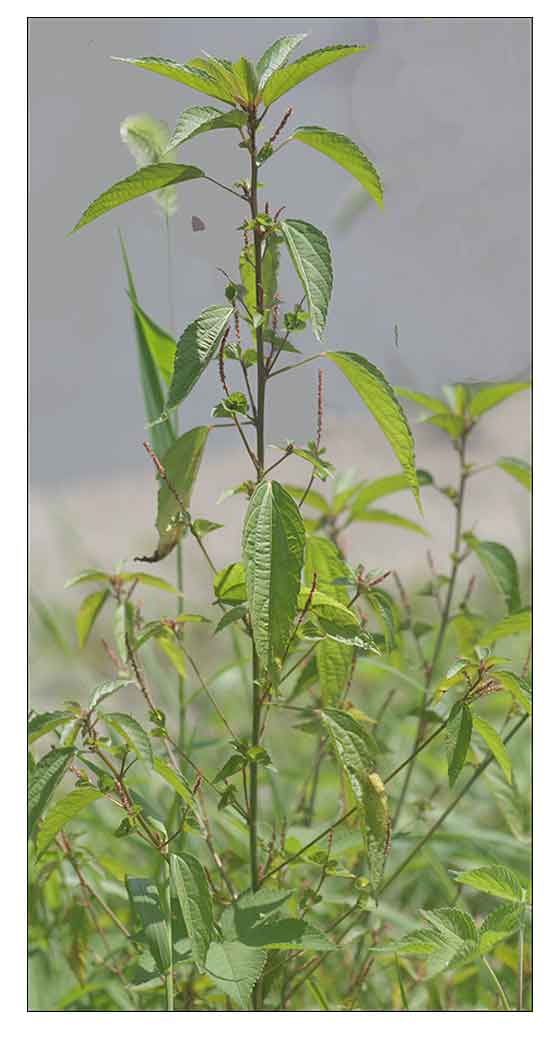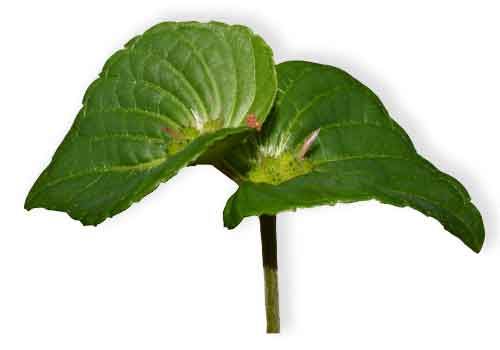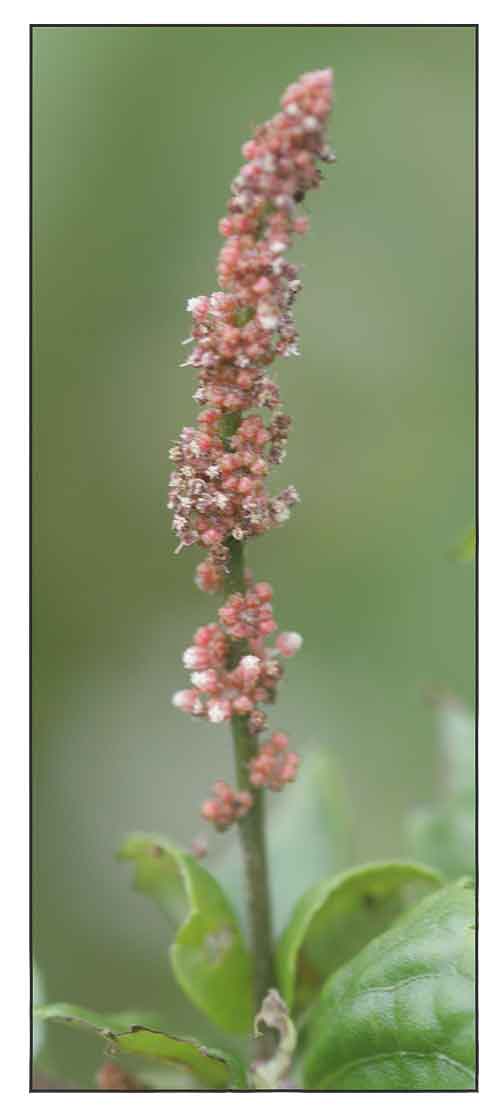 Gen info Gen info
- Acalypha is a genus of flowering plants in the family Euphorbiaceae. It is the sole genus of the subtribe Acalyphinae. It is one of the largest euphorb genera, with about 450 to 460 species. The genus was first described by Linne (1753) in the Species Plantarum.
-
Acalypha australis, commonly known as Asian copperleaf, is a species of flowering plant in the family Euphorbiaceae native to eastern Asia.
- Etymology: The genus name derives from Ancient Greek word akalúphe (nettle), an alternative form of akalephe, which was inspired by nettle leaves.
Botany
• Annual herbs, 0.2-0.5 m tall, monoecious. Branchlets pilose. Stipules lanceolate, 1.5-2 mm; petiole 2-6 cm; leaf blade oblong-ovate, ± rhombic-ovate, or broadly lanceolate, 3-9 × 1-5 cm, membranous, abaxially pilosulose along veins, adaxially glabrous, base cuneate, rarely obtuse, crenate, apex shortly acuminate. Inflorescences axillary, rarely terminal, unbranched, 1.5-5 cm, pilosulose, bisexual; peduncle 0.5-3 cm; female bracts proximal, 1 or 2(-4), ovate, cordate, accrescent to 1.4-2.5 × 1-2 cm in fruit, pilose, margin crenate; male portion distal, short to almost capitate, slender; bracts ovate, ca. 0.5 mm. Male flowers 5-7 per bract; pedicel ca. 0.5 mm; calyx segments 4, ca. 0.5 mm; stamens (7 or)8. Female flowers 1-3 per bract, sessile; sepals 3, narrowly ovate, 0.5-1 mm, pilose; ovary pilose; styles 3, ca. 2 mm, 5-7-laciniate. Capsule 3-locular, ca. 4 mm in diam., pilose and tuberculate. Seeds subovoid, 1.5-2 mm, smooth. (Flora of China)
• Herbs, annual, 3–6 dm, monoecious. Stems erect, densely to sparsely pilose. Leaves: petiole 0.5–4  cm; blade ovate to broadly lanceolate, 2–8 × 1.5–4 cm, base cuneate to obtuse, margins serrate, apex acute to short-acuminate. Inflorescences bisexual, axillary; peduncle 0.5–4(–6) cm, pistillate portion 1–2 × 1.5–2.5 cm or pistillate bract solitary, staminate portion 0.5–3 cm; allomorphic pistillate flowers rare, when present replacing staminate part of inflorescence. Pistillate bracts (normal flowers) loosely arranged (inflorescence axis visible between bracts) or solitary, 10–15(–20) × 8–12 mm, abaxial surface sparsely pubescent; lobes 12–15, rounded, 1/20 bract length; of allomorphic flowers absent. Pedicels of allomorphic flowers rudimentary. Pistillate flowers: pistil 3-carpellate (normal flowers), 2-carpellate (allomorphic flowers); styles multifid or laciniate. Capsules muricate, pubescent; allomorphic fruits obovoid, 2 × 1.2 mm, muricate, pubescent. Seeds 1.5–1.8 mm, minutely pitted. (Flora of North America) cm; blade ovate to broadly lanceolate, 2–8 × 1.5–4 cm, base cuneate to obtuse, margins serrate, apex acute to short-acuminate. Inflorescences bisexual, axillary; peduncle 0.5–4(–6) cm, pistillate portion 1–2 × 1.5–2.5 cm or pistillate bract solitary, staminate portion 0.5–3 cm; allomorphic pistillate flowers rare, when present replacing staminate part of inflorescence. Pistillate bracts (normal flowers) loosely arranged (inflorescence axis visible between bracts) or solitary, 10–15(–20) × 8–12 mm, abaxial surface sparsely pubescent; lobes 12–15, rounded, 1/20 bract length; of allomorphic flowers absent. Pedicels of allomorphic flowers rudimentary. Pistillate flowers: pistil 3-carpellate (normal flowers), 2-carpellate (allomorphic flowers); styles multifid or laciniate. Capsules muricate, pubescent; allomorphic fruits obovoid, 2 × 1.2 mm, muricate, pubescent. Seeds 1.5–1.8 mm, minutely pitted. (Flora of North America)
Distribution
- Native to the
Philippines. (1) (2)
- In open places near streams and settlements. (2)
- Also native to China North-Central, China South-Central, China Southeast, East Himalaya, Hainan, Inner Mongolia, Japan, Korea, Laos, Manchuria, Nansei-shoto, Philippines, Primorye, Qinghai, South China Sea, Taiwan, Tibet, Vietnam. (1)
Constituents
 - Chemical analysis of A. australis samples from cultivated gardens, fields, and roadsides in Iraq revealed a variable groups of important bioactive compounds such as benzoquinones and its derivatives 2,6-dimethoxy – 1,4- benzoquinones which has an important roles as antioxidants compounds; anthraquinones group with trihydroxyanthraquinones; antioxidant phenols group represented by brevifolin carboxylic acid, gallic acid and some of its derivatives as protocatechuic acid, flavonoids compounds as rutin and kaempferol, and terpenoid as loliolide compound. Chemical analysis elucidated other compounds as phytosterols (β-sitosterol and daucosterol), butanedioic acid, and niacin.
(10) - Chemical analysis of A. australis samples from cultivated gardens, fields, and roadsides in Iraq revealed a variable groups of important bioactive compounds such as benzoquinones and its derivatives 2,6-dimethoxy – 1,4- benzoquinones which has an important roles as antioxidants compounds; anthraquinones group with trihydroxyanthraquinones; antioxidant phenols group represented by brevifolin carboxylic acid, gallic acid and some of its derivatives as protocatechuic acid, flavonoids compounds as rutin and kaempferol, and terpenoid as loliolide compound. Chemical analysis elucidated other compounds as phytosterols (β-sitosterol and daucosterol), butanedioic acid, and niacin.
(10)
Properties
- Studies have suggested anti-inflammatory, anti-metastatic, anticancer, apoptotic, anti-adipogenic, antiobesity, antibacterial properties.
Parts used
Whole plant, leaves.
Uses
Edibility
- Regarded as an edible wild vegetable in souther China.
(7)
Folkloric
- No reported folkloric medicinal use in the Philippines.
- Whole plant and aerial parts are used in traditional Chinese medicine, including clearing heat, detoxification, promoting diuresis, resolving food stagnation, astringency to stop bleeding. It is commonly used for enteritis, external hemorrhage, eczema, dermatitis, and snake bites. (7)
- Whole plant used for dysentery, diarrhea, scrofula, dermatitis, nosebleeds, hemoptysis, coughs and swollen feet. Leaves used for poulticing snakebites. (11)
Studies
• Anti-Adipogenic / Anti-Obesity / Dried Plants: Study of evaluated the anti-obesity properties and underlying mechanism of A. australis (ALL) on high-fat diet (HFD)-induced obese mice and 3T3-L1 adipocytes to develop a new functional food material. ALL administration significantly suppressed body weight gain, reduced fat pad weight and Lee's index in obese mice, with no effect on liver/kidney index. AAL also reduced TC, LDL-C, triglyceride and increased HDL-C levels. Histological exam showed significant amelioration of lipid accumulation in the liver and subcutaneous adipose tissue. In vitro, AA: inhibited adipose differentiation by down-regulating gene and protein expression of PPARγ and C/EBPα. AAL also reversed HFD-induced intestinal dysbacteriosis. Results suggest the AAL water-soluble extract has significant anti-adipogenic effect in HFD-induced obese mice model. (4)
• Attenuation of DDS-Induced Ulcerative Colitis: Study of evaluated the therapeutic effect of aqueous extract of A. australis (AAL) on ulcerative colitis (UC) in mice and its potential mechanism. The AAL extract significantly reduced expression of NF-kB pathway-related proteins, and reduced serum levels of IL-2,IL-8, IL-17A, !L-22, IFN-γ, and TNFα, and decreased apoptosis in the colon. Study suggests AAL can protect against UC mainly by inhibiting expression of NF-kB pathway-related proteins and reducing the release of inflammatory factors. (5)
• Anti-Inflammatory: In a study of methanol extracts of Chinese medicinal plants for anti-inflammatory activity, the ME of A. australis (AAL) was found to be most effective. In Chinese medicine, AAL has been used for clearing heat, toxic material, and hemostasia. Study evaluated the anti-inflammatory effect of AAL and its underlying mechanism in vitro and in vivo. AAL inhibited NO production and iNOS expression in LPS-stimulated RAW 264.7 macrophages. AAL reduced production and mRNA expression of TNFα and IL-6 and inhibited NF-kB related genes in LPS-stimulated RAW 264.7 macrophages. AAL increased survival rate by inhibiting iNOS expression in LPS-induced septic mice and decreased IL-6 and IL-1ß mRNA expression through inhibition of NF-kB related genes in LPS-induced septic mice. (6)
• Inhibition of B16 Melanoma Cell Metastasis: Melanoma is a highly malignant and invasive skin tumor, with the highest mortality among skin cancers. Study revealed 2 mg/mL AAL effectively suppresses the metastasis of B16 cells, while simultaneously triggering expression of key apoptosis-related proteins, including Bcl-2, Bax, and cleaved caspased 3. AAl exerted the inhibitory effect via the P13K/AKT signal transduction pathway, evidenced by deficits in Ras, AKT, p-AKT, and P13K expression levels. Results suggest potential for AAL as therapeutic option for reducing the metastatic potential of B16 melanoma cells. (7)
• Tracing Antibacterial Compounds: Study evaluated the antibacterial activity of Acalypha australis by HPLC/MS fingerprints. Results showed gallic acid and a compound with molecular weight of 634.1 as the main antibacterial compounds, both of which increased the antibacterial efficacy 10 to 20 times. (8)
• Apoptosis and Molecular Mechanisms in Human Oral Cancer Cells: Study evaluated the apoptotic activities and molecular mechanisms of methanol extracts of Acalypha australis (MEAL) and Dianthus chinensis (MEDC)in human oral cancer cells. Sp1 was overexpressed in oral tumor tissues. Down regulation of Sp1 inhibited growth of SCC-15 and YD-15 oral cancer cells. MEAL inhibited cell growth and induced apoptosis in both cell lines by decreasing expression of Sp1. Treatment also decreased Mcl-1 expression, which is a downstream target of Sp1. Results showed MEDC and MEAL are natural products that can potentially induced apoptosis of tumor cells that overexpress the Sp1 protein. (9)
Availability
- Wild-crafted.
- Supplements, capsules, powder in the cybermarket.
|

![]()






